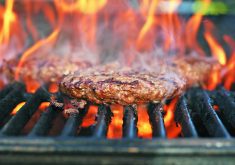Snow is accumulating in Saskatoon as I write this May 4 but we must assume that barbecue season will eventually arrive. When it does, you want to be ready, right? Fortunately some Western Producer colleagues and clients recently got a lesson in the art of barbecue, by no less an expert than Todd Hulse, general manager of Fiorella’s Jack Stack Barbecue in Kansas City, Missouri.
I don’t know about you, but I had never heard of Jack Stack Barbecue until last month, but it is apparently a famous American brand name that is renowned for the quality of its barbecued meats. There are four locations in Kansas City and it also ships $3.5 million worth of product annually all over the United States. Not to Canada, however, due to various regulations.
Suffice to say, then, that the folks at Jack Stack know what they’re doing when it comes to barbecued meat. The group noted above saw how it was done and tasted the results, and I wasn’t the only one to be impressed with the flavour and quality.
Hulse and pitmaster Tim Keegan begin with high quality meat and they cook it low and slow.
When it comes to steak, Hulse provided a handy method for estimating doneness without stabbing or cutting into the meat, which releases needed juices. It is called the finger test, which is demonstrated in the accompanying photos.



Cooking meat in a huge smoker, as Jack Stack does, is much different from cooking meat on your gas barbecue. So we asked Hulse about replicating his delicious results with the standard Canadian grill out on the back deck. He was loath to promise great results, but suggested the gas barbecue be augmented by a small smoker box that contains wood chips. By wetting down the wood chips and putting them in the gas barbecue with the meat, you can partially replicate the smoky style of Kansas City barbecue. When the chips start to smoke, start cooking.
Read Also

Budget seen as fairly solid, but worrying cracks appear
The reaction from the agriculture industry to prime minister Mark Carney’s first budget handed down November 4th has been largely positive.
Other tips provided by Hulse and Keegan:
1. When barbecuing shrimp, cook it only until it forms a nice “C” shape. If your shrimp curls beyond that, it is overdone.
2. When it comes to beef, they prefer meat aged 21 days.
3. Different woods provide different smoke profiles. Apple and cherry wood provide a sweeter flavour, while mesquite and hickory provide other flavours.
4. Let your steak rest for about five minutes after cooking before you cut into it. This allows the juices to settle back into the meat, retaining a juicier steak.
5. When it comes to ribs, those from the back of the pig are more meaty and tender than spare ribs from the side.
6. You know the ribs are done when the meat starts to pull back from the bone, and when the slap bends slightly when you hold the end of the slab with tongs.















